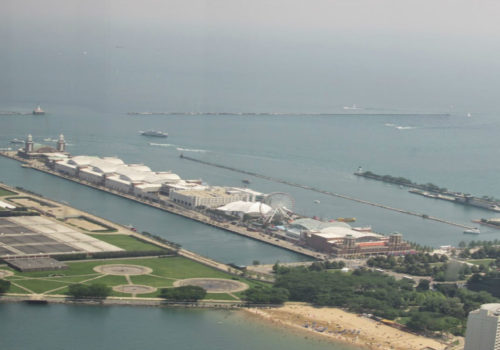The Federal Judiciary Should Increase Its Equity in the Stock of US Foreign Policy by Using the Political Capital of the Alien Tort Statute
I. Introduction
II. Stock of US Foreign Policy
III. Political Capital of the Alien Tort Statute (ATS)
IV. Federal Judiciary’s Role in Globalization and Democratization
V. Counterarguments and Responses
|
I. Introduction
1. Hypothetical: The Case Heard Round the World
In a case[1] that made news headlines around the world, the United States Supreme Court affirmed a lower court’s $25 million judgment against a dictator’s son under the Alien Tort Statute (ATS)[2]. After the Court’s ruling, the President of the United States (US) summoned the national security advisors and senior Cabinet officials for a foreign policy strategy session. Once the strategy session was completed, the President sought feedback from Congress on the suggestions that were put forward at the strategy session; specifically, the President spoke to the chairs of the US Senate Foreign Relations Committee, US House Foreign Relations Committee, and other senior members of Congress on devising a new foreign policy strategy for the dictator’s region that would be more in line with the Supreme Court’s decision.[3] As a result of the Court’s decision, the President and Congress now had to adjust their relationship with the dictator and other dictators in the region.
The case involved a civil suit that was brought against an African dictator’s son who had been criminally convicted of torture and conspiracy to torture. The civil suit was filed by a group of international human rights organizations on behalf of the victims pursuant to the ATS. The victims had been subjected to torture under directives from the dictator’s son in his capacity as the commander of a militant group. The militant group was part of the national law enforcement division of the dictator’s oppressive regime, and the activities of the militant group were what allowed the dictator to keep such a strong hold on power.
The impact of the Court’s decision was felt in the US and beyond. At some level, the Court’s decision shifted the power structure in the dictator’s country with the subsequent dissolution of the militant group. Other dictators in the region took steps to ease attacks against their political opponents. Also, the Court’s decision led to a reshuffling of US foreign policy goals in the region. As a result of the Court’s decision, the President and members of Congress now found it too politically expensive to be seen as having a cozy relationship with dictators in the region.
Prior to the federal courts’ involvement in this case, US foreign policy efforts in the region were somewhat incoherent. The efforts exuded a preference for the stability of dealing with dictators over the unpredictability of dealing with democracies; but at the same time, the efforts emphasized the importance of democratic values. The federal courts’ involvement in this case and the Court’s ruling fell decisively on the side of democracy over dictatorship, greatly improving the courts’ institutional brand. The management of the case was applauded domestically and internationally by pro-Democracy and human rights activists. Several scholars opined that if the US courts had not taken on this case, some other national court outside of the dictator’s country or perhaps a supra-national court would have found a way to take on such a high profile case.[4] As a result of the US federal courts’ management of this case and the Court’s authoritative ruling, the federal judiciary has placed itself in a position to match the appeal of international courts and create the conditions for democratic values to thrive.
2. Discussion Overview
This paper argues that the federal judiciary, as a self-interested institution just like the political branches,[5] ought to use the ATS as a way to increase its role in shaping US foreign policy toward democratic values in a world that’s becoming more globalized. The paper conceptualizes international relations as a stock exchange[6], foreign policy as a stock[7], and the ATS as political capital[8]. In essence, federal courts can access the political capital of the ATS through their interpretation of the law and then use that political capital as a kind of payment to secure more power in foreign policymaking and greater participation in international relations. Admittedly, some of the implications of discussing government interests as economic and financial concepts are beyond the scope of this paper; nevertheless, this paper attempts to shed new light on the federal judiciary’s interests by framing such interests as similar to those of an economic actor[9] in a globalizing world.
Part II begins by discussing the concept of foreign policy as a stock that is traded and exchanged in the stock exchange of international relations. In addition, this section discusses some of the main institutional interests for the three branches of the US government as it relates to ownership of US foreign policy stock, with a special focus placed on the federal judiciary. Part II ends with a discussion on the two primary types of trading that take place for US foreign policy stock in the stock exchange of international relations: war-making and peace-making.
Part III discusses the significance of the ATS and how it allows US courts to take jurisdiction over cases brought by non-US nationals seeking tort damages for serious violations of international law, regardless of where the alleged tort occurred or who committed it. Further, this section examines how the ATS allows federal courts to pull customary international law into federal common law and thus expand the influence of ATS on international law. Part III ends with a suggestion of how the significance of ATS translates into real political power for federal courts i.e. political capital.
Part IV discusses how the federal court system, from the standpoint of a self-interested institution, can take advantage of its access to the political capital of the ATS to maximize its profile in a changing world. The political capital of the ATS can serve as the judicial branch’s investment, an upfront payment that Congress made available to the judiciary as far back as1789, to counter the rising power of international tribunals and supranational courts. More importantly, the judicial branch can use the political capital of the ATS as a down-payment to support the next wave of democratization[10]—and in effect, shape US foreign policy strategy to be more consistent with American democratic values.[11]
Part V addresses counterarguments. Notably, the overall position I take in this paper can be classified as a prescriptive argument. Accordingly, the arguments against my position can be divided into two categories, descriptive and prescriptive. As an illustration, the descriptive counterarguments will generally reject the way in which I describe the federal judiciary’s role in shaping foreign policy i.e. these counterarguments are “counter-descriptions”. And the prescriptive counterarguments will generally reject my recommendation that the federal judiciary increase its role in shaping foreign policy i.e. “counter-prescriptions”.
II. Stock of US Foreign Policy
1. Ownership of “Foreign Policy Stock”: An Institutional Interest for the Three Branches of US Government.
Foreign policy can be conceptualized as a stock. By “stock,” I mean to invoke the manner in which stock is used in finance to indicate the ownership interest in a portion of a corporation’s assets and liabilities.[12] In other words, if the US were a corporation, the federal government – a government for the people and by the people – would have an ownership interest in its assets and liabilities.[13] This ownership interest can be represented as a stock. Specifically, it can be represented as a “policy stock” because policies are what guide the government’s use of state power to fulfill its governance responsibilities.[14] Conceptually, there are two types of policy stock in the national governance of a country: foreign policy stock and domestic policy stock. This paper focuses primarily on the federal government’s interest in US foreign policy stock, specifically the judicial branch of the federal government.
The US Constitution established three branches of the federal government: Legislative, Executive, and Judicial[15]. Continuing with the finance concept of stock, the three branches of the federal government can be viewed as three separate owners of a single company. The Constitution established these three separate branches under a principle of separation of powers and a system of checks and balances to minimize the likelihood of power abuse by the federal government.[16] Each branch is a separate entity and has its own set of governance responsibilities. Generally speaking, the legislative branch makes the laws, the executive branch enforces the laws, and the judicial branch interprets and applies the laws.[17]
The legislative and executive branches are sometimes referred to as the “political branches” of the federal government in contrast to the judicial branch.[18] This is because members of the federal judiciary and Supreme Court are not elected but rather are appointed according to the US Constitution.[19] Although, in theory, the federal judiciary plays no political role; nevertheless, in practice, many of its decisions have real impact on the federal government’s power structure.[20] The federal judiciary has an existential interest in fulfilling its constitutional responsibilities. But fulfilling these responsibilities is not a process that plays out in a vacuum, instead it is a process that occurs vis-à-vis the other branches’ interests in fulfilling their own governance responsibilities.[21] As such, the federal judiciary wields measurable power; and since policies are what guide a government’s use of state power to fulfill its responsibilities, the federal judiciary ought to embrace its interest in shaping foreign policies.
1. Textual View of the Federal Judiciary’s Interest in Foreign Policy
The text of the Constitution gives the judicial branch an equity interest in the stock of US foreign policy. Article III of the Constitution addresses the federal judiciary’s role in foreign affairs in a number of ways. It states that the “judicial Power of the United States, shall be vested in one supreme Court, and in such inferior Courts…” This judicial power shall extend to various enumerated “Cases” and “Controversies”.[22] The most important categories of Article III jurisdiction are federal question jurisdiction – cases “arising under this Constitution, the Laws of the United States, and Treaties”; and diversity jurisdiction – controversies between parties of diverse citizenship.[23] The Founding Fathers viewed the establishment of a powerful national judiciary as an important development, and saw the absence of such a judiciary as one of the main defects in the Articles of Confederation.[24]
Article I, Section 8 and Article II largely authorize the federal political branches to conduct foreign relations through provisions such as the declaration of war,[25] commerce with foreign nations,[26] Commander-in-Chief,[27] and enactment of treaties.[28] In essence, the legislative and executive branches can be seen as the two primary traders of US foreign policy stock in the stock exchange of international relations. However, the judicial branch is also a participating trader in the stock exchange of international relations. Art III extends the federal judicial power to cases involving federal enactments of treaties and other transnational controversies. The Founding Fathers, through the text of the Constitution, placed the federal judiciary in a position of owning up to the task of resolving legal controversies flowing from the laws and treaties of the United States. The judicial branch stands to lose a great deal of “institutional competence”[29] if it somehow refuses to live up to this responsibility, regardless of whether the controversies are predominantly domestic or foreign in nature.[30] Consider the Supreme Court’s early recognition of this significant responsibility:
“It is emphatically the province and duty of the judicial department to say what the law is. Those who apply the rule to particular cases, must of necessity expound and interpret that rule. If two laws conflict with each other, the courts must decide on the operation of each.” Chief Justice John Marshall, Marbury v. Madison (1803).
From a textual standpoint, the issue is not whether the federal judiciary has a role to play in foreign relations but how much. The “how much” question is one that has caused some debate among scholars.[31] Perhaps a brief survey of some of the functional benefits of the federal judiciary’s role in foreign relations might be a more effective way to gauge “how much” the courts should be involved in foreign relations, as textual interpretations are potentially more susceptible to ideological biases.
2. Functional View of Federal Judiciary’s Interest in Foreign Policy
Throughout history, it’s been in the federal judiciary’s interest to maintain its constitutionally-given power as the leading interpreter of US laws (and the policies behind those laws), even into the arena of foreign relations.[32] A functional view must examine the federal judiciary’s role in foreign policy in terms of its costs versus its benefits.[33] The main cost of the federal judiciary’s involvement in foreign policy is that a court’s ruling may send mixed messages to foreign nations if one of the other branches has expressed a preference for the losing litigant.[34] However, the judicial branch’s role in foreign relations can produce more benefits than costs.[35] From the perspective of equity finance, in an enterprise where two owners are managers or have voting rights, it’s advisable to have a third owner serve as a kind of tie-breaker or deal-maker during a dispute.[36] This principle seems to be one of the reasons why the Founding Fathers wanted the federal judiciary to have a more prominent national role than it had during the Articles of Confederation period.[37] It’s impossible to imagine how the Founding Fathers would have given the federal judiciary a stake in the federal government without any participating role in one of the two primary functions of a national government– foreign policy.[38]
There’s little question of the functional superiority of the President in foreign affairs, however, any suggestions that the federal judiciary plays no functional role in such affairs are a bit misguided.[39] For example, it is well accepted in the stock exchange of international relations that foreign nations have standing to sue in US courts when they are suing private parties or more significantly when they are seeking to protect their own assets.[40] In this sense, the federal judiciary serves the function of an impartial arbiter for foreign governments in a way that the federal political branches might not be able to serve. Another functional role that the federal judiciary plays in foreign relations is in the determination of sovereign immunity especially with regard to the Foreign Sovereigns Immunity Act (FSIA).[41] In specific situations, foreign nations and government officials are immune from lawsuits in US courts.[42] The idea of sovereign immunity is borne out of the common law doctrine that the sovereign or state cannot commit a legal wrong, and the comity that US courts sometimes give to foreign laws and decisions. One of the purposes of the FSIA was “to transfer the determination of sovereign immunity from the executive branch to the judicial branch, thereby… assuring litigants that these often crucial decisions are made on purely legal grounds and under procedures that insure due process.”[43]
The role that the federal judiciary plays in foreign policy has a constitutional foundation and diplomatic function which together produce more benefits than costs. The federal judiciary can further increase the benefits, and reduce the costs, of its involvement in foreign affairs by slanting its focus towards its institutional competence for peace-making.
2. War-making and Peace-making: Two Types of Trading for US Foreign Policy Stock in the Stock Exchange of International Relations
The foreign policy stock is traded and exchanged in the stock exchange of international relations. Just as stock traders take positions in buying and selling stocks in the financial markets, national governments take positions in supporting and opposing international issues. Stock traders take the positions they do in anticipation of potential earnings; similarly, national governments take the positions they do in anticipation of potential benefits to their nations.[44] Generally, there are two primary types of trading that take place for US foreign policy stock in the stock exchange of international relations: war-making and peace-making. A national government can take a position of making war[45] or it can take a position of making peace i.e. providing and encouraging dispute resolution that does not require the use of force.[46] The US Constitution commits the issue of war-making to the political branches,[47] and the federal judiciary’s role in war-making seems relatively limited.[48] However, Article III’s “Case” and “Controversy” clause expressly invites federal courts to be peacemakers, even in foreign affairs.[49]
Peace-making in the stock exchange of international relations usually touches on many issues, but none of these issues test the institutional competence of courts as much as the issue of international human rights.[50] Federal courts can approach their responsibility to resolve issues involving international human rights by using their interpretative power in two key areas of international law: treaties and customary international law.[51] The Founding Fathers wanted to establish a federal government that would be able to ensure that the US carried out international obligations under both treaties and customary international law.[52] Customary international law is instrumental in international peacemaking.[53] However, the text of the Constitution emphasizes treaties much more than customary international law.[54] Historically, this emphasis placed the federal courts in a tough, as well as strategic, position with regard to international peacemaking.[55] On one hand, federal courts had a significant role in peacemaking; on the other hand, their ability to use their interpretative power to incorporate customary international law into federal law for peacemaking purposes seemed too limited.
Congress, as the branch of government with the highest interest in lawmaking, has the most authority to incorporate customary international law into US federal law using its Article I powers. For example, Congress’s Article I powers include the Define and Punish Clause, which allows Congress to “define and punish Piracies and Felonies committed on the high Seas, and Offences against the Law of Nation”.[56] Congress effectively gave some of this authority to the federal courts by enacting the Alien Tort Statute (ATS), and later reinforcing ATS’s use as a vehicle for international human rights litigation by enacting the Torture Victim Protection Act (TVPA)[57].
III. Political Capital of the Alien Tort Statute (ATS)
The ATS and TVPA share a lot in common and courts tend to treat the TVPA as a more detailed version of the ATS.[58] In that vein, the “political capital of the ATS” as that phrase is used throughout this paper refers to both statutes’ potential to allow federal courts the ability to have universal jurisdiction and to incorporate certain human rights norms into federal law.
1. ATS Permits Universal Civil Jurisdiction
ATS passed in 1789 as part of the Judiciary Act.[59] The text of the statute is short and somewhat ambiguous. It provides that “district courts shall have original jurisdiction of any civil action by an alien for a tort only, committed in violation of the law of nations or a treaty of the United States.”[60] The ATS does not specify who may be liable under its provisions and thus the nature and scope of liability is unclear. What the ATS does seem to do is allow federal courts to take jurisdiction over cases brought by non-US nationals seeking tort damages for serious violations of international law, no matter where the alleged tort occurred or who committed it. Although the particular type of jurisdiction under the ATS may vary with the facts of each case;[61] however, in its broadest application, the ATS permits universal civil jurisdiction.[62]
The ATS offers real political capital in the sense that no other country has a statute quite like the ATS.[63] Most countries have not even considered the legality or utility of exercising universal civil jurisdiction, which means that the federal judiciary’s role in interpreting the ATS is at the cutting edge of state practice.[64] ATS claims can proceed for any harm resulting from a violation of international law, no matter where the harm occurred, or who inflicted the harm, as long as the plaintiff serves process in a U.S. territory.[65] ATS claims can proceed against both natural persons and legal persons, but claims against state governments are precluded by sovereign immunity.[66] The torts that qualify as violations of the law of nations are usually those that are specific and egregious or widely condemned acts of wrongdoing.[67] The international legal norms that will qualify as a cause of action under ATS must be “specific, universal, and obligatory.”[68] For example, federal courts have held that genocide, war crimes, and crimes against humanity (and the torture used to perpetrate these crimes) are classic violations of the law of nations under the ATS, even when committed by an individual outside of state action.[69]
Notably, federal courts have used the ATS to expand their jurisdiction over less egregious acts, but this expansion has been institutionally sound. In Adra v. Clift,[70] a federal district court in Maryland found that passport fraud was litigable under ATS. But the federal judiciary’s interest in investing ATS political capital in the form of universal jurisdiction has not been so self-seeking as to trump institutional competence concerns. For example, the Supreme Court in Sosa held that a brief unlawful detention in which torture occurred did not warrant ATS damages.
2. ATS Allows Federal Courts to Pull Customary International Law (CIL) into Federal Common Law
The other aspect of ATS political capital is the ability to pull customary international law (CIL) into federal common law. CIL is the contemporary equivalent of the “law of nations” referenced in the text of the ATS. An alien could have a cognizable claim in a U.S. court for a tort committed in violation of certain international human rights norms if CIL acquired domestic legal status as federal common law through the ATS.[71] Scholars widely viewed the Second Circuit’s 1980 decision in Filartiga v. Pena-Irala[72] involving the ATS as an incorporation of CIL into U.S. domestic law, and an important mechanism for the development of international law generally. Filartiga was the first modern decision to enforce CIL in federal court through the ATS.[73] Prior to Filartiga, some leading international law scholars had advocated for the use of domestic courts to incorporate international law into domestic U.S. law but there was no clear way for courts to pull CIL into federal common law.[74] As a result of Filartiga, the discussion began to shift from whether the federal judiciary has “CIL incorporation” power to whether the federal judiciary should exercise such power.[75][76]
The Supreme Court, acting in its own institutional interest, solidified the federal judiciary’s CIL incorporation power under the ATS.[77] The Court interpreted the ATS’s meaning and scope and concluded that the ATS permitted federal courts to hear federal common law claims based on a select number of CIL violations.[78] The Court concluded that the substantive evolution of CIL could lead to new causes of action under the ATS as long as they were sufficiently specific, universal, and obligatory CIL norms.[79] Tying causes of action under the ATS to the evolution of CIL gives the federal judiciary significant power because, by definition, CIL “results from a general and consistent practice of states followed by them from a sense of legal obligation.”[80] International norms that gain the status of a general and consistent practice can potentially lead to new causes of action for aliens.[81]
IV. Judicial Branch’s Role in Globalization and Democratization
1. ATS as Upfront Payment to Match the Rising Power of International Courts
As the world has become more globalized, the federal judiciary’s role in shaping US foreign policy has become subject to competition not just from the political branches but also from international courts.[82] Many of these international courts gained their institutional power and status from their involvement in international human rights[83] – an involvement that grew partly out of the effects of globalization.[84] The physical boundaries that once separated countries have given way to a global economy, instant communication, quicker travel, and the spread of criminal and tortious acts that impact human rights internationally. Globalization has led to the establishment of an International Criminal Court, the creation of ad hoc tribunals for Rwanda and the former Yugoslavia, and the expanding use of domestic courts to bring criminal and civil cases against individuals accused of human rights violations.[85] Although claims analogous to the ATS can be brought in other non-US forums;[86] nevertheless, the political capital of the ATS allows US courts to uniquely match the rising power of international courts.
International courts,[87] for the most part, are creatures of contemporary history with their development tied to that of the United Nations beginning in the 20th century.[88] On the other hand, the ATS has been on the books since 1789. Although the legislative history of the ATS is limited, most scholars agree that it was intended to assure foreign governments that the United States would act to prevent and provide remedies for breaches of CIL, especially breaches concerning diplomats and merchants.[89] In effect, the ATS’s potential as a form of political capital was in place well before the rise of international courts.
International courts play a key role in foreign relations as their interpretation of international law has both a direct and an indirect impact on foreign relations.[90] As an illustration of the role international courts play, consider that the International Criminal Tribunal for Rwanda (ICTR) broadened the reach of international law in a 1998 ruling by opining that rape is a crime of genocide. “From time immemorial, rape has been regarded as spoils of war. Now it will be considered a war crime. We want to send out a strong message that rape is no longer a trophy of war,” the presiding judge said in a statement.[91] Equal to the task of playing its own creative role in foreign relations through the ATS, the federal courts have left the window open for corporate liability in international law – a move that if further exploited would likely be a break from the international law tradition of not including corporations within the scope of liability.[92]
Conceptually, the political capital of the ATS serves as a kind of upfront payment to match the rising power of international courts which are making international law and in turn shaping foreign relations. The notion of upfront payment is derived from the status of the ATS as a law that consists of the powerful principles of universal jurisdiction and incorporation of CIL, and the status of the ATS as a law that came before the rise of international courts. From this standpoint, the political capital of the ATS gives US courts just as much interest to participate in foreign relations as international courts.
2. ATS as Down-Payment to Support Democratization
Dignity is at the core of international human rights.[93] And democracy offers the best hope that every global citizen is treated with dignity.[94] But the move from dictatorship to democracy, referred to as “democratization”,[95] has the potential to cause a number of human rights violations.[96] The political branches face the challenge of balancing the desire for political stability in foreign nations (which make for simpler foreign policy strategies[97]) with the commitment to take positions in foreign relations that speak to American democratic values. Democratization can be a messy business at times with developments that may not align well with political stability.[98] As a result of the challenge faced by the political branches, the stock of US foreign policy is often traded in an unbalanced way.
The judicial branch can use the political capital of the ATS as a down-payment to support or at least buoy the support for democratization.[99] For example, in February 2011, the Obama administration was criticized by one group of pundits for not doing enough to support the pro-Democracy forces that were calling for the removal of Dictator Hosni Mubarak as the president of Egypt.[100] Another set of critics were criticizing the Obama administration for not standing behind Mubarak who they viewed as a symbol of political stability,[101] despite his record on human rights violations.[102] In the midst of responding to these two different groups of critics, the Obama administration came up with a plan for managing the crisis in Egypt that some scholars believe was unbalanced.[103] In the aftermath of the Egyptian crisis, politicians and human rights activists alike began assessing ways to secure a path from dictatorship to democracy in Egypt;[104] and many of the stakeholders would like the courts to be part of that process for the sake of securing justice or at least creating an environment for it.[105]
The federal judiciary’s increased role in shaping a foreign policy strategy will render such a strategy more consistent with American democratic values, in the same way the Founding Fathers wanted a stronger national judiciary to guarantee a more perfect union. The political capital of the ATS gives the US court institution the ability to enhance its international profile as a guarantor of global justice in a globally connected world. The notion of using the political capital of a statute as a way to promote democratic values is right on cue with constitutional tradition.[106] According to the text and spirit of the Constitution,[107] the political branches can always, in effect, recover some amount of the political capital of the ATS that the federal judiciary decides to invest in support of democratization. The political branches can recover this down-payment in a variety of ways which include passing a new law or signing a treaty that limits the potency of the ATS.
V. Counterarguments and Responses
So far, this paper has laid out a prescriptive argument for how the federal judiciary, in light of its institutional interest in national governance, can use the ATS to increase its role in shaping US foreign policy strategy in order to match the rising power of international courts and promote democracy. As such, the principal challenges to this paper will likely fall into two categories: descriptive or prescriptive. The descriptive counterarguments will generally reject my description of the federal judiciary’s role in shaping foreign policy; or these counterarguments will reject my description of the political capital of the ATS. The prescriptive counterarguments will generally reject my recommendation that the judicial branch increase its role in shaping foreign policy; or these counterarguments will accept my recommendation that the judicial branch increase its role but reject the use of an ATS mechanism to do so. This section of the paper addresses these counterarguments.
1. Counter-Descriptions
Some may disagree with my description of the federal judiciary’s role in shaping foreign policy based on their view that the text of the Constitution gives no foreign relations power to the federal judiciary. Article I, Section 8 and Article II make foreign affairs exclusively a political exercise. Furthermore, the Supreme Court itself recognized in 1803 that based on the Constitution, the federal judiciary has no role to play in foreign affairs as evidenced by Justice Marshall’s depiction of these affairs as “political”[108] and primarily the responsibility of the executive branch.[109]
This argument fails to fully appreciate the Article III powers of the judicial branch. The Founding Fathers wanted a more prominent role in national governance for the federal judiciary, especially after the Articles of Confederation experiment proved unsuccessful. This more prominent role necessitated the judicial branch’s involvement in foreign affairs as demonstrated by Art III’s Vesting Clause, Jurisdiction Clause, and Case and Controversy Clause. Moreover, the Supreme Court famously opined in that same 1803 case that the judicial branch has the power to “say what the law is.”[110] Regardless of its foreign policy implications, the ATS is “the law of the United States” and, as such, it is part of “the supreme Law of the Land”[111] that federal courts must interpret.
Others may disagree with my description of the federal judiciary’s functional role in shaping foreign policy based on their view that such an involvement adds no net value to foreign relations i.e. the costs outweigh benefits; or there are no benefits at all. In other words, the judicial branch’s role in foreign affairs complicates matters for the executive branch – the primary stockholder of US foreign policy. Specifically, the federal courts’ ATS rulings send mixed messages to foreign nations.[112] Furthermore, the powers of the judicial branch to interpret the law are not consolidated in one person as in the case of the executive branch, so different judges draw different conclusions based on different judicial philosophies which add unnecessary confusion to the structuring of US foreign policy.[113]
There are at least three problems with this argument. First, it assumes that any functional role of the judicial branch in foreign affairs automatically translates into an interference of the executive branch’s role. This interference concern has also been used to critique Congress’s role in foreign affairs.[114] Nevertheless, history shows that the legislative branch and the judicial branch both play institutional roles in foreign affairs.[115] This paper’s argument for the courts’ increase of its foreign relations power would necessarily be a subtraction from Congress’s power, not the President’s. Conceptually speaking, although the judicial branch’s increase in its equity interest would be actualized vis-à-vis both of the political branches, the increase is made possible strictly from Congress’s equity share in the form of the ATS. Theoretically, the executive branch would not be giving up any of its powers directly to the courts but would need to accommodate the new power arrangement if the courts were to obtain more power in foreign relations via the ATS.
Second, if the purpose of the ATS is “to promote the development and enforcement of CIL generally, and human rights more specifically,”[116] then out of all the three branches, the judicial branch is best positioned from a functional standpoint to ensure the purpose of the statute. The judicial branch is in the business of promoting justice and rights; the courts’ institutional competence, demonstrated by its functional role as an impartial arbiter, trumps any concerns over ATS rulings sending mixed messages. Moreover, even with the executive branch, there are times that mixed messages are sent to foreign nations e.g. State Department vs. Defense Department—consider the response to Dictator Muammar Gaddafi’s killing of civilian protesters in March 2011.[117]
Third, the judicial branch can be viewed as a class of investors. The difference of opinions within the members of the class is not substantial enough to breakdown the shared interest in institutional competence because each judge’s legacy is tied to the integrity of the judicial branch as an institution. As such, the institutional benefits that would come from an increased role in foreign affairs in a globalizing world would be enjoyed by each member of the judicial branch, whether or not that member agreed with the means to procure those benefits.
Some critics may reject my description of the ATS as political capital under the universal jurisdiction prong based on their view that states will always fight back against such jurisdiction because of sovereign immunity interests. This argument ignores the trend in recent history that shows that states are warming up to the idea of universal jurisdiction for criminal actions[118] and for civil actions.[119]
Other critics may reject my description of the ATS as political capital under the incorporation of CIL into domestic law prong based on their view that such incorporation was limited to specific actions by the Supreme Court in Sosa. More so, the 2nd Circuit’s ruling in Kiobel that ATS claims cannot touch corporations shows that the federal judiciary is not in the mood to contribute to the expansion of CIL. The first part of this argument fails to take into account that full implications of the Sosa decision. Make no mistake, in Sosa, the Court affirmed Filgarta’s use of ATS to incorporate CIL into domestic law; also, the Court left the window open for new ATS causes of action by tying it to the evolution of CIL. Moreover, the Supreme Court has not spoken on the issue of corporate liability under ATS as of March 2011 and other federal courts have hinted at such liability in opposition to Kiobel.[120]
2. Counter-Prescriptions
Even if some critics might accept my description of the judicial branch’s role in foreign relations and the political of the ATS, they may not accept my recommendations on how the judicial branch ought to increase such role. Some may reject my recommendation that the federal judiciary increase its role in shaping foreign policy based on their view that such an increased role will lead to increased risk of institutional degradation. In essence, the federal courts risk being seen as institutionally incompetent when they take on issues that can be deferred to the political branches.[121] For example, peace-making and war-making are difficult to distinguish; also, court decisions that cut against foreign policy views of political branches may face problems of enforcement. All in all, the political capital of the ATS is not sufficient to manage these risks and the judicial branch would be prudent to let the political branches and international courts manage these risks.
This line of argument is well-intentioned but underestimates the pace of globalization and desire for democratization. The judicial branch’s acceptance of a stagnant, business-as-usual role that makes no use of ATS political capital is riskier than investing that capital to boost its international profile.[122] As the world becomes more globalized, more issues will become a hybrid of domestic and foreign affairs, and the federal judiciary will need to be more creative to match the rising power of international courts and fulfill its institutional responsibility of upholding constitutional values.
Some critics might accept my recommendation that the judicial branch increase its role in foreign affairs but reject the use of an ATS mechanism to do so. They may argue that the political capital of the ATS is unstable as the executive and legislative branch can curb the potency of the ATS with laws, treaties, and regulations. The federal judiciary can better expand its role by utilizing its traditional Article III powers.
The problem with this argument is that the Constitution does not seem to have a universal jurisdiction manifesto in the manner of the ATS; nor does the Constitution outline a clear path for the incorporation of CIL into domestic law. And the absence of these principles tends to create an incomplete manual for how the federal judiciary ought to interact on an expanding global stage, beyond the American context.[123] And even if there are other judicial tools from constitutional provisions that might speak to the absence of these two principles, the fact of the matter is that the political branches would still be able to curb the reach of these principles, especially in the realm of foreign relations where the political branches participate more regularly in the trading of US foreign policy stock in the stock exchange of international relations.
Conclusion
In a world that’s becoming more globalized and democratized with each news cycle, branches of governments increasingly have to negotiate the use of state power nationally as well as internationally through evolving policies. These policies are what guide governments’ use of state power to fulfill governance responsibilities. The judicial branch of the United States (US) government has a vested interest in the judicial power of the US and a responsibility that extends to all cases arising under the laws of the US. The Alien Tort Statute (ATS) is a law of the US that gives US federal courts universal jurisdiction over any tort committed in violation of customary international law (CIL) or US treaty. The elements of universal jurisdiction and domestic incorporation of CIL in the ATS have real foreign policy implications.
ATS rulings can shape US foreign policy toward a more humanitarian and democratic value system. In addition, ATS rulings can allow the judicial branch to be a more influential player in the development of CIL and thus match the rising power of international courts. For these reasons, the federal judiciary, as a self-interested institution committed to its governance responsibilities, ought to use the ATS as a key investment tool in negotiating its portion of the use of US power nationally and internationally, particularly as it relates to its role in foreign relations.
[1] This hypothetical story of a dictator’s son found liable under the Alien Tort Statute (ATS) is based loosely on the ATS civil suit against Charles MacArthur Emmanuel aka “Chuckie Taylor Jr.” – the son of the former President of Liberia, Charles Taylor. In that case, the federal court found Taylor Jr. liable to his victims for damages of $22 million as reported by Human Rights USA on February 5, 2010. See humanrightsusa.org. This story fits within the first category of “Plaintiff’s Diplomacy”, a phrase developed by Anne Marie-Slaughter and David Bosco to describe lawsuits that shape foreign policy; the first category poses the least risk to the integrity of US courts because it involves suits against individuals for grave violations of international law, and is closest to the Hostis humani generis (Latin for “enemy of mankind”) standard. https://www.princeton.edu/~slaughtr/Articles/PlaintiffFA.txt (last visited March 24, 2011).
[2]28 U.S.C. §1350 (2005).
Conception of the Treaty Power, 98 MICH. L. REV. 1075, 1080 (2000) (Consider the discussion of Missouri v. Holland, 252 U.S. 416 (1920) and “how the Court decided it under the long shadow of the Treaty of Versailles, which was before the Senate at the same moment. It was well known that Versailles would soon give birth to the first human rights conventions on the problem of child labor. The Court thus self-consciously opened up the possibility that its own controversial decision in Hammer v. Dagenhart 247 U.S. 251 (1918), rendered only two years before Missouri, might be avoided through the ratification of an international human rights treaty”).







